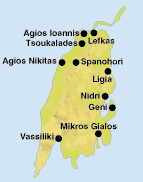|
| |
|
|
|
|
LEFKAS |

|

|
|

|
Lefkas Town, the island's capital, is
situated at the north end of the island beside the narrow isthmus. It is a
fascinating hotchpotch of narrow streets, timber, stone and even
corrugated iron houses, with a busy harbour full of yachts. The town hosts
a number of art and cultural festivals throughout the summer. The
fascinating Epiros coast on the mainland is within easy reach across the
swing bridge with its guardian fort of Agia Mavra.
Nidri, on the coast road 15 kms south of
Lefkas Town, is a bustling resort in a beautiful setting from where boat
trips can be taken to Onassi's island of Skorpios, Meganisi and the Inner
Islands. There is a ferry port with a daily scheduled service to Kefalonia
and Ithaka and nearby a waymarked trail leads up to the Dimosari
Waterfalls. Waterfalls are unique in the Ionian, where most of the
rainfall disappears deep into the underlying limestone. Vasiliki, further
down the coast is one of the world's finest windsurfing locations and
another ferry port for Kefalonia.
To discover the real Lefkas, take any of
a number of quiet country roads that wind up green valleys towards the
rugged mountains. Apart from the outstanding views of the inner Ionian Sea
dotted with islands, many of the oldest monasteries can be explored
including Agia Panaghia Odigirata, near Lefkas Town on the main road to
Lazarata. Dating from the 15th century, with wonderful frescoes, recently
restored, this is just one of many old churches scattered across the
island. West and north of the mountains there are a series of traditional
stone-built villages untouched by tourism. Typical of these are the 5
villages surrounding Lazarata, including Spanachori. Here, the newly
restored Architect's House, is a good example of how traditional building
methods can be used to create a comfortable modern home in keeping with
its surroundings.
These quiet villages, set back from the
coast, are ideal bases from which to explore Lefkas' magnificent west
coast. From the village of Agios Nikita, set in a glorious position above
a crescent of sand and soft shingle, a whole series of wonderful beaches
run north and south, some such as Mylos only accessible by water taxi. To
sit on an empty beach as the sun sinks gently towards the western horizon,
towering white cliffs glowing pink and the sea turning from turquoise to
deep blue, this would surely be one of life's most memorable experiences.

|
| Lefkas
is Greek for white, and the island takes its name from the brilliant white
of the limestone rock. From the dramatic sea cliffs and magnificent
beaches of the west coast, across the rugged peaks of the interior
mountains and down through fertile, stream fed valleys to the gentler east
coast with its wooded bays and quiet creeks, Lefkas is made for leisurely
exploration.
An island only since the sixth century
BC when a channel was dug through the low isthmus connecting it to the
mainland. Lefkas has its own unique appeal, possibly due to the fact that
the Venetians handed over the island to the Turks in the 16th and 17th
century, in return for control of nearby Kefalonia and Ithaka. On the
other hand, could it have a connection with the romantic legends of two
renowned beauties from a much earlier age?
Sappho, desperate after being spurned by
her lover, fled to the high cliffs of Cape Lefkadas on the extreme
southwestern tip of the island. Here she threw herself into the sea, in
ancient times a certain cure for unrequited love. She died! Over the
following centuries, criminals and lunatics were forced to repeat the act,
sometimes with rudimentary wings attached, by priests from the nearby
temple of Apollo in an annual ceremony. Nowadays, hang gliders and para
sailors manage Sappho's Leap with much more success. In the 8th century
AD, Saint Mavra, the black saint famous for her beauty and purity, sought
sanctuary on the White Island to escape an unwanted suitor. She lived in
solitary contemplation until her death, when her saintdom was assured
after the discovery that her tomb would cure sickness and drive out evil
spirits.
Today, Lefkas is still largely an
agricultural island with thriving olive groves, vineyards and a famous
lace-making cottage industry. Development of tourism has been confined to
a few resorts such as Vasiliki and Nidri on the east coast. Elsewhere, the
loudest noise might be from the surf breaking on soft shingle or the echo
of goat bells through the olive trees. In spring, rare orchids thrive on
the verges and the woods are bright with the purple blossom of the Judas
tree. Many of the older women in the rural areas still wear the
traditional Lefkadian dress, consisting of two skirts, a brown headscarf
and a rigid bodice. Stop for a retsina in a small kafenion and soon you
will be engaged in conversation by a friendly local, who will be only too
happy to point out all the local attractions.
 |
|
|
|
|
